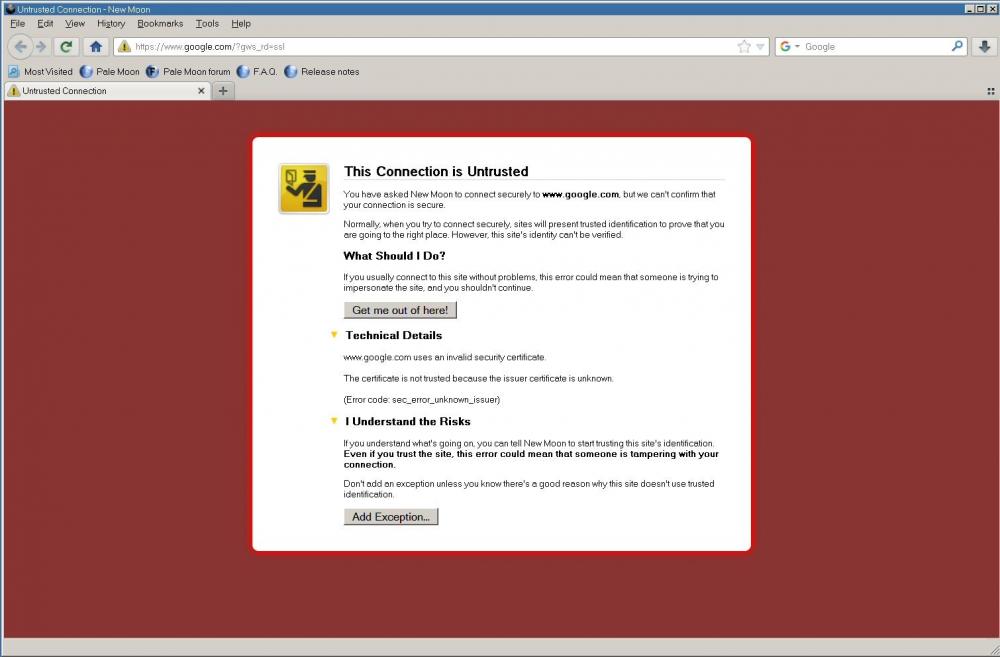Content Type
Profiles
Forums
Events
Everything posted by Dave-H
-
OK, I hit F12 immediately after the browser loaded, and the inspector window came up (complete with Chinese tab labels!) No sign of any activity, but you can see from the screen grab the loading animation on the New Tab. It stays there until I load another page, at which point it get overwritten, and subsequent new tabs don't show it.
-
It's set to open chrome://newtab on startup using the "open a specific page or set of pages" option. If I don't have anything in the home page address field and set it to "open home page" it's exactly the same. I doubt that, it loads pretty fast and works pretty fast, and there's no problem with anything else.
-
LOL, busted! Yes, "writeable" is correct, which I almost immediately discovered and edited the post. I'm not sure why I thought it was wrong! As regards the editing, when I edit my posts I see this underneath. "Show that the message has been edited" is not checked by default. I thought that was something that came in when the forum software was last updated, but if others aren't seeing it, maybe it's because I'm now a moderator.
-
I did look at that one, but it doesn't flag up wrongly spelled works while you are typing them anywhere, which is what I'm used to with Firefox. However, I have found one which does do that! It's this one here. It uses an online dictionary rather than one stored on the machine, so it's not as fast as the inbuilt Firefox version, but it's pretty good and does everything I need. Well recommended! Just as an aside, do you know why when I load a new tab when the browser starts, it has a progress animation on the tab as if it's trying to load something? This never goes away. It doesn't appear on subsequent new tabs, just the first one when the browser starts up.
-
@NotHereToPlayGames Hi again ArcticFoxie. Still getting my head around configuring 360Chrome 13.5. Do you know if there is an English spell checker that will work with it? 360Chrome doesn't seem the have the inbuilt Chrome spell checker that most references refer to. American English will do, although British would be better! I've looked at the available extensions, but none of them do what I want, which is to highlight mis-spellings as I type in website forms. I'm really missing the spell checker in Firefox 52.9 ESR! Thanks, Dave.
-

Instagram videos not working in Firefox 52 ESR?
Dave-H replied to Dave-H's topic in Browsers working on Older NT-Family OSes
I have UBO 1.16.4.30 installed on Firefox 52.9. I did try putting a previously recommended filter into it, but it makes no difference. It's - instagram.com##div.ZyFrc[role=dialog]:style(display: block !important) Is there another one I can try? -

Instagram videos not working in Firefox 52 ESR?
Dave-H replied to Dave-H's topic in Browsers working on Older NT-Family OSes
Yes those two video links work in Firefox 52.9 ESR. The problem is not that IG videos have stopped working completely, it's that they have stopped being displayed in the feed. If you click on the comments of an entry in the feed where there is a video missing, when the comments window opens the video plays fine there next to the comments. It doesn't show in the feed though, that's the problem. Sorry, I should have been more specific! -
@NotHereToPlayGames Hi ArcticFoxie, I'm trying to use an extension called New Tab Tools with 360Chrome 13.5, as I've always used it with Firefox to give me a new tab page with a "speed dial" of shortcuts on it. The new tab page at the moment appears to be blank, and I can't see how to restore the usual Chrome one. Without that I don't think the extension will be any use. It apparently installed OK, but the settings are greyed out, and although I can apparently add sites to the new tab page, I can't see them. I guess the extension modifies the usual Chrome new tab page, so how do I get that back? Thanks, Dave.
-

Instagram videos not working in Firefox 52 ESR?
Dave-H replied to Dave-H's topic in Browsers working on Older NT-Family OSes
In my experience, Serpent 55 appeared to use Firefox Sync, which really got my hopes up, but it refused to actually connect for me. Serpent 52 uses Pale Moon Sync. -

Instagram videos not working in Firefox 52 ESR?
Dave-H replied to Dave-H's topic in Browsers working on Older NT-Family OSes
OK, I've tried with Serpent 52, and yes the Instagram videos (and comments view) work there fine! Unfortunately, Facebook still has the problem that you can't post, text entry doesn't work. I would really like to find a Mozilla-based browser that works properly on everything in XP, but so far no joy. If it could still use Firefox Sync to synchronise with my other Firefox browsers that would be the icing on the cake! 360Chrome still seems the best option at the moment I'm afraid. -

Instagram videos not working in Firefox 52 ESR?
Dave-H replied to Dave-H's topic in Browsers working on Older NT-Family OSes
Thanks, I'll give Serpent 52 a try! -

Instagram videos not working in Firefox 52 ESR?
Dave-H replied to Dave-H's topic in Browsers working on Older NT-Family OSes
It was actually Serpent 55 I tried it on, but yes, exactly the same problem. I haven't tried New Moon. -

My Browser Builds (Part 3)
Dave-H replied to roytam1's topic in Browsers working on Older NT-Family OSes
Happy New Year to you too! I certainly tried all that with Firefox, but it never made any difference to the Instagram videos problem. It has happened before, and a fix was found, but I haven't been able to identify what needs to be done this time. It's some sort of javascript issue I think, which Firefox 52 ESR (and presumably Serpent which is based on it) cannot cope with. It was Serpent 55 which I tried incidentally. I was impressed with it, but as it didn't fix the Instagram problem I think I will stick with 360Chrome for the moment, it works fine there. -

My Browser Builds (Part 3)
Dave-H replied to roytam1's topic in Browsers working on Older NT-Family OSes
Just an observation about the latest Serpent build, it has the same problem now with Instagram as Firefox 52.9 ESR does. No videos are displayed. -

My Browser Builds (Part 3)
Dave-H replied to roytam1's topic in Browsers working on Older NT-Family OSes
Ah, thank you, of course, it's because I'm using ProxHTTPSProxy! That never occurred to me, I completely forgot that I had to configure Firefox to allow for that. You're a star! -

My Browser Builds (Part 3)
Dave-H replied to roytam1's topic in Browsers working on Older NT-Family OSes
It certainly looks like something like that, but everything else is working fine! How can I check that and correct it? -

My Browser Builds (Part 3)
Dave-H replied to roytam1's topic in Browsers working on Older NT-Family OSes
Hi everyone, Happy New Year! I'm just trying out some new browser options, because I fear that my old faithful Firefox 52 ESR is getting near the end of its usability now. I've tried Arcticfoxie's version of 360Chrome, which looks promising, but as someone who has generally always used Firefox, I wanted to try some of the offerings here. I first tried the latest version of Serpent, which I was told some time ago is closest to Firefox, although it's now being discontinued I gather. I also tried the latest New Moon. They both run fine, but they both have the same problem. On virtually every website, I get this - Something is obviously fundamentally wrong somewhere, unless I'm missing something really obvious! I can override the warning on some sites (but not all) and the sites then load, but surely this shouldn't be happening? -
I did think of that, but it would be a bit ridiculous if 360Chrome couldn't cope with that! I had actually already tried using its 8.3 DOS name E:\DUMPFOLD but that made no difference. Further experiments show that I can use the E:\ root as the destination, and a subfolder of E:\Dump Folder as well, e.g. E:\Dump Folder\Test. Works fine, no problem with spaces then. It seems that the only path I can't use is the one I actually want to use! I'm still wondering if it's because it's configured as the system "My Documents" folder. Perhaps 360Chrome doesn't like that for some reason. I should add that E:\ is a FAT32 formatted drive, so there definitely shouldn't be any permissions problems! Setting the download folder to E:\Dump Folder\Test Folder also works. It's only E:\Dump Folder which seems to be "unwritable"!
-
No, it's a separate fixed disk which is my archive storage drive, where all my pictures and videos etc. are stored. It's connected internally to the motherboard, but via an add-on SATA card. That has never made a difference before, and I can actually use the root of the drive to store downloads, but not the Dump Folder subfolder. E:\Dump Folder is actually also the "My Documents" folder, if that makes any difference. It certainly doesn't to any other programs.
-
Hi @NotHereToPlayGamesAKA ArcticFoxie! I've just decided again to see how your latest version 0f 360Chrome version 13.5 works with my system. After spending some time on the configuration, I'm impressed, it's working very well! No crashes or other malfunctions as yet. One puzzling thing I've come across though is the download folder setting. I don't want to use the default, which is D:\360Down (my XP is installed on drive D:), I want to use my normal temporary file store with is at E:\Dump Folder. Unfortunately, when I try to use it I just get a message saying "Path is not writable. Please Choose another folder". I am very puzzled by this, as that folder is perfectly writeable, I write to it dozens of times a day! All my research on this just points to permissions problems, but we're talking about XP here, permissions don't apply (at least when you've got simple file sharing enabled, which I have). Any idea why 360Chrome can't write to that folder when everything else can? Cheers, Dave.
-

Instagram videos not working in Firefox 52 ESR?
Dave-H replied to Dave-H's topic in Browsers working on Older NT-Family OSes
The Instagram videos aren't working again for me now in Firefox 52.9 ESR. Can anyone else confirm this? Carousel videos are just a white space, single videos don't appear at all, I suspect they've just collapsed to a single line again. -
Thanks, more food for thought! One thing I am now certain of after my experiments with George is that this machine will not work properly with XP in ACPI Multiprocessor mode. I'm having exactly the same problems with his clean installation as I was having with my original installation. Many USB devices are not detected in multiprocessor mode, and the AHCI driver refuses to work as well. Those problems all immediately go away if I switch to standard ACPI mode. What the actual cause is I have no idea, but I suspect it's a resources problem of some sort.




